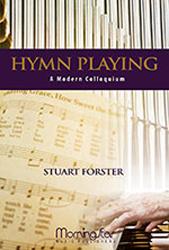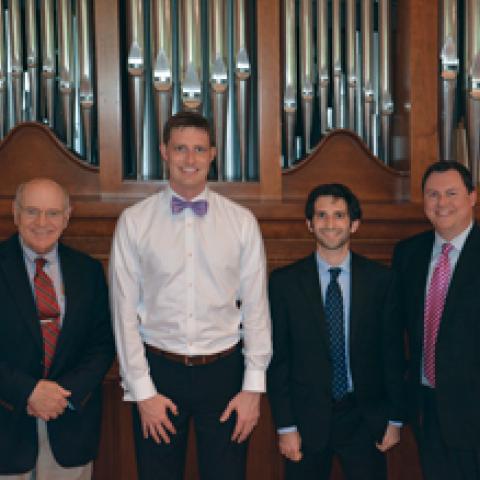Blest be the tie that binds
Our hearts in Christian love;
The fellowship of kindred minds
Is like to that above.
That’s one of the great old chestnuts of hymnody. Who reading those words doesn’t have that tune buzzing in their ears? Everyone knows it. Verse after verse goes by, each building on the way we depend on each other, support each other, and live with each other. It’s usually in F Major or G Major—I prefer G, or maybe start in F and modulate a couple times. Nice to step the tonic of the last chord down a major third, let that become the dominant of the new key, throw in the seventh, and start This glorious hope revives . . . up a half step!
The text is by John Fawcett, London, 1782. The tune is Dennis by Hans Nägeli (1773–1836) and later adapted by Lowell Mason (The Psaltery, 1845). It’s as familiar as they come. But did you ever stop to think that the meter (SM; 8.8.6.6.8) is that of a limerick? Everybody sing:
Writing a limerick’s absurd,
Line one and line five rhyme in word,
And just as you’ve reckoned,
Both rhyme with the second;
The fourth line must rhyme with the third.
To make this trick work, you may choose between including the upbeat or not, and you sometimes have to place two or more syllables on the last beat of a line. Everybody sing:
There once was a fellow named Beebe,
Planned to marry a woman named Phoebe,
He said, “I must see
What the minister’s fee be,
Before Phoebe be Phoebe Beebe.”
§
Last month our friend Jim passed away. His death is a first for us—the first of close friends roughly our age to pass away—and he’s been on my mind a lot. He was a prolific organic gardener and a quintessential “foodie.” He had a great love and real appreciation for fine wine and, since a recent trip to Scotland, single malt scotch. He played guitar a little, and he and his wife Lois were frequent attenders and strong supporters of musical ensembles, especially the Boston Symphony Orchestra and the Metropolitan Opera. They traveled together frequently, especially to Italy where they spent much time and had many friends.
In addition to all this, Jim was a geologist, and he had a huge collection of minerals and ores. After his death, Lois is dealing with the dispersal of hundreds of specimens. Some are the size of a chestnut while others are huge—too heavy for one person to carry. The garage and basement are full of Jim’s rocks. Thankfully, Jim’s friends from the Boston Mineral Club have rallied to help with the task. That fellowship of kindred minds—each individual a little crazier than the last—is a tight society of people who are passionate about the variety of minerals that comprise the earth. You might say (as they often do), they have rocks in their heads. But they sure have been wonderful to our friend Lois in her sadness. Everybody sing:
Some people I hang with are jocks
With an aura of dirty white socks.
When they ask me to play
I say, “Maybe some day.
But my principal passion is rocks.”
§
Last summer Wendy and I launched and christened our new boat, Kingfisher. She’s a Marshall 22 built by Marshall Marine in Padanaram, which is a village of South Dartmouth, Massachusetts, just across a bay from the great fishing and whaling capital of New Bedford, an easy sail in a small boat from Nantucket. She’s a broad-beamed, gaff-rigged craft of a class that was used originally for commercial fishing before boats had engines because she can carry lots of cargo and can be sailed single-handed. When I tell people she’s a catboat, they often think of those little rocketship-boats with two hulls. No, not a catamaran, a catboat. She’s only twenty-two feet long, but more then ten feet wide, with lots of space inside for hauling fish! She has a centerboard so we can go into shallow inlets, a little diesel engine to keep us off the rocks, and pretty, classic lines.
Even before we had a chance to put her in the water we joined the Catboat Association. There are about four hundred members, and annual dues are $25. Last February we attended the CBA Annual Meeting at the Marriott Hotel in Groton, Connecticut. We had such fun that we’re going again this year—we’ll miss the Super Bowl, but I’d rather talk about boats. Having been to lots of meetings of pipe organ groups, I’m used to seeing displays of combination actions, tuning tools, CDs, and published music in the exhibition room. This time it was boats on trailers, wood carvers (who could make you a bowsprit or a ribbon-shaped name board for your transom), a couple of smart guys from Yanmar (Japanese manufacturer of marine diesel engines), and monogrammed life jackets. There were workshops about sail handling, navigating, diesel engine maintenance, and lots of storytelling. This fellowship of kindred minds organizes races and other fun events. Catboats, for all their practicality and beauty, are not very fast. One wag spoke up in an open forum saying, “If you wanted to go fast, you should have bought a bicycle.” Racing catboats is a little like racing turtles. May the best man win. Everybody sing:
We’re gathered to talk about boats.
At our meetings, we never take notes.
We organize races
In watery places,
And officers win with most votes.
§
In the summer of 2010, Wall Street Journal reporter Jennifer Levitz was covering a story in Washington, D.C., when she noticed a large crowd milling about in the front yard of a church. When she realized they were all wearing nametags on lanyards she figured they were part of a convention and like any good reporter, she walked across to investigate. She was dumbfounded to learn that they were all organists attending a convention, a fellowship of kindred minds. It had never crossed her mind that organists would gather for large professional meetings so she asked a lot of questions about the current state of the pipe organ. She mentioned that she was based in Boston and someone suggested she should interview me to learn about the role of the organ in modern society.
The result was a story in the Wall Street Journal with the headline, “Trafficking in Organs, Mr. Bishop Pipes Up to Preserve a Bit of History.” (See http://tinyurl.com/mc9xu2y.) The story begins, “John Bishop leaves the soul-saving to the clergy. He’s content to save the pipe organs—and even that isn’t easy.”
By the way, I suggest there are three areas of public life where puns are
a nuisance:
1. Pipe organs (organ donor, organ transplant, piping up, Swell, Great, Positiv?)
2. Boat names (Liquid Assets, A Crewed Interest, Ahoy Vey)
3. Beauty shops (Shear Delights, The Mane Attraction, A Cut Above)
Feel free to continue with new categories!
In response to Jennifer’s call, we met at Starbucks near Faneuil Hall in Boston. We chatted over lattés for an hour or so. Jennifer is a tall, quick-witted, athletic woman, and from her enthusiasm about my topic, you might have thought she had been interested in the organ all her life. But as this was her first foray into our winded world, I took her through Organ Building 101, Church Music 101, and AGO 101. When she asked what I was working on at the moment, I invited her to come with me to Cambridge, near Harvard Square, that afternoon, where I was meeting with officials of Lesley University. The school had purchased a vacant building, formerly the North Prospect Congregational Church, and planned to move the building across its lot to adjoin a planned new building where it would become part of the Art Library, and the Aeolian-Skinner organ was being offered for sale.
Jennifer’s article concluded:
It can take years to place an organ, but sometimes there are matches made in music heaven. Within weeks of visiting Lesley University, Mr. Bishop found a home for its organ in a church in Texas. It was loaded onto a tractor-trailer, and off it went, the victory recorded by Mr. Bishop on Facebook.
“Another one leaves town ahead of the wrecking ball,” he wrote.
Everybody sing (add another syllable!):
We’re glad to have all that publicity.
Helps preserving works of historicity.
She wrote in the paper
’Bout that tricky caper;
By writing, she joined in complicity.
§
In 1956, Walter Holtkamp installed a revolutionary organ in the tower gallery of the chapel at the Episcopal Theological School (now Episcopal Divinity School) on Brattle Street in Cambridge, Massachusetts—again, near Harvard Square. My father, a retired Episcopal priest, was instructor of Homiletics there when I was a teenager, and he introduced me to Dr. Alastair Cassels-Brown who was professor of church music there, and with whom I had my first years of organ lessons on that Holtkamp organ.
Over a number of years I learned various tidbits about the early history of that organ; that Charles Fisk was an apprentice with Holtkamp, that E. Power Biggs lived a few blocks away, that Daniel Pinkham as a young disciple of Biggs was always around, that organ historian Barbara Owen was a close part of that circle, and that Melville Smith (director of the Longy School of Music and organist at the First and Second Church in Boston) was strongly connected with the seminary, and friend with all those others. The Holtkamp organ—with low wind-pressures, slider-windchests (though electro-pneumatic action), baroque-inspired reeds, full principal choruses, and a Rückpositiv—was quite the statement for 1956. And that fellowship of kindred minds (Holtkamp, Fisk, Pinkham, Owen, and Smith) must have had some heady conversations as the organ was being installed.
Christ Church (Episcopal) in Cambridge is an eighteenth-century building, complete with Revolutionary War bullet hole, around the corner from the seminary chapel. Stuart Forster is the current organist, and the World War II era Aeolian-Skinner has been replaced by a stunning new organ by Schoenstein. E. Power Biggs was appointed organist there in 1932, work that coincided with his blossoming concert career. In his book All the Stops (PublicAffairs, 2003, page 86), Craig Whitney relates a (to us) delightful story from that era:
Juggling all this took its toll, and when the rector of Christ Church asked Biggs to read the early Sunday service in addition to his musical duties, Biggs refused. The upshot was reported by Charles Fisk, a nine-year-old member of the church’s boy choir, in a note dated January 2, 1935, in the diary his mother had given him for Christmas. “I went to choir practice,” Fisk wrote. “Mr. Biggs wasnt there.” For (at least) the second time, Biggs had been fired from a church job. The leadership of Christ Church had decided that “Mr. Biggs” was more interested in his professional concert career than he was in being a good church musician, and they were right.
Everybody sing:
The choirboys all had to stand,
At a wave of the organist’s hand.
But Charlie had noted
And later he wroted
That dear Mr. Biggs had been canned.
§
The same year that Holtkamp installed the organ at the seminary, Rudolf von Beckerath installed a four-manual Werkprinzip tracker-action organ with sixty-five ranks at Trinity Lutheran Church in Cleveland. You can read all about that landmark organ at its own website: http://clevelandbeckerath.org/beckerathorgan.html.
That instrument was a major step toward the revival of interest in classic styles of organbuilding. In the following few years, many more new European-built organs were imported to American churches and schools, notably the 1958 Flentrop installed at the instigation of E. Power Biggs in the Busch-Reisinger Museum (now Adolphus Busch Hall) at Harvard University. That’s the organ on which he recorded the wildly popular series Bach Organ Favorites for Columbia Records—a series that still stands as the best-selling solo classical recordings of all time. Nice going, Biggsy!
In June of 1956, G. Donald Harrison was hard at work finishing the great Aeolian-Skinner organ at St. Thomas Church on Fifth Avenue in New York. He was working under a whopping deadline—Pierre Cochereau, organist of the Cathedral of Notre Dame in Paris, would be playing the opening recital on June 25 as part of the 60th national convention of the American Guild of Organists. During those weeks, New York was suffering both a heat wave and a taxi strike. After working late on June 14, Harrison walked to his Third Avenue apartment, ate dinner with his wife Helen, and sat down to watch Victor Borge present his shenanigans on television. At 11:00 p.m. he suffered a heart attack and died.
Last Christmas, and the previous two Easters, Wendy and I have worshipped at St. Thomas Church, to bask in the glorious sounds of the Choir of Men and Boys led by John Scott, who must be considered among the finest living church musicians. And, it’s a poignant thought that as I write, today is the second anniversary of the death of Dr. Gerre Hancock who led the music there with such distinction from 1971 until 2004.
I never had a chance to meet G. Donald Harrison, but I can at least say our lifetimes overlapped—by less than two weeks. I was born on March 16, 1956!
As we think about the big changes that were going on in the American pipe organ industry, it’s fun to note other developments in the music world. On January 5, 1956, a truck driver named Elvis Presley made his first recording, “Heartbreak Hotel.”
§
Tom Gleason was Wendy’s Russian History professor at Brown University. He was a wonderful mentor, and as Wendy babysat for his kids when she was a student, Tom and his wife Sarah have remained dear friends to this day. Our daughter Meg was also Tom’s student at Brown—Tom and Sarah were hosts for Meg’s graduation party in their house and garden. And Tom and Sarah joined us for a sailing vacation around Greece’s Dodecanese Islands in the Aegean Sea. Tom and I share a fellowship of kindred minds with a love of limericks. Now, let’s face it, the limericks I’m sharing here, most of which are mine, are not the sort that we usually hear. But in the pages of this august journal, I’m not going there. Everybody sing:
The limerick packs laughs anatomical
In a space that is most economical.
But the good ones I’ve seen
So seldom are clean,
And the clean ones so seldom are comical!
The limerick is furtive and mean.
You must keep her in close quarantine.
Or she sneaks to the slums
And promptly becomes
Disorderly, drunk, and obscene.
(Modulate up a step, kindred minds.)
The next time we’re sitting at table,
And finish the sharing of fable,
We’ll pour from the jugs
And hoist up our mugs,
Sharing limericks as rude as we’re able.




